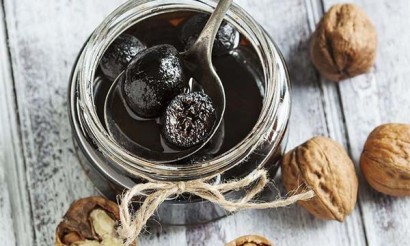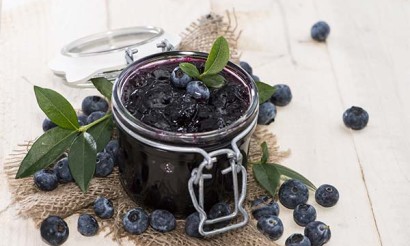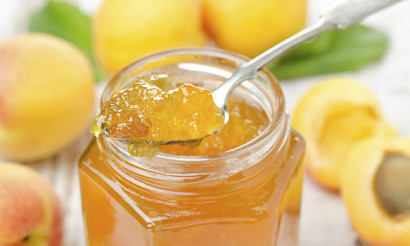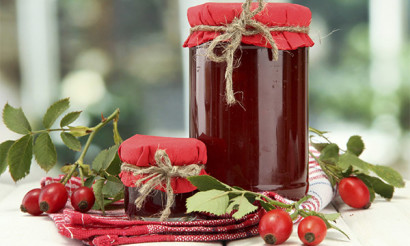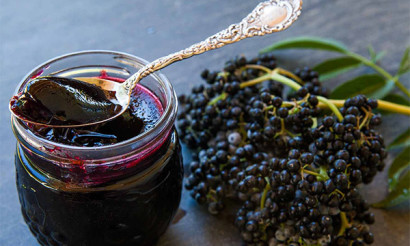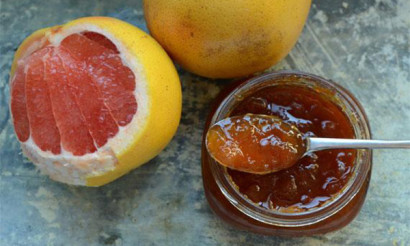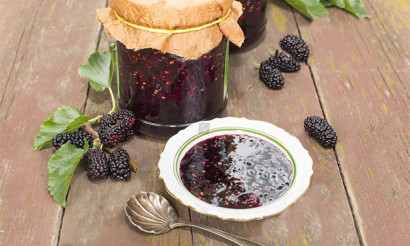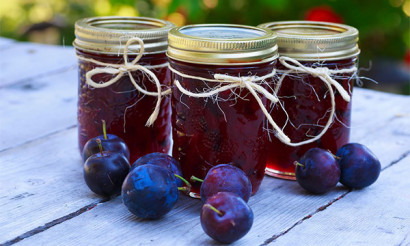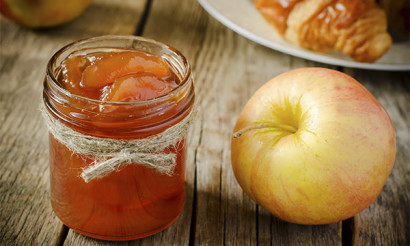Peach jam: 8 recipes for cooking
Peach jam is an incredible delicacy that will appeal to people of all ages. It is excellent for use both in warm and in cold seasons, has a gorgeous taste characteristics, a noble amber-golden color, ease and wide variability of preparation.
- Composition and calories
- What is useful for peach jam
- How to choose peaches for jam
- General rules and recommendations
- How to make jam from peaches: Recipes
- Regular peach jam for winter
- Peach jam with almonds
- Peach jam "Aromatic" with cinnamon
- Minimalistic jam made of whole peaches
- Greek-style vitamin peach jam for the lazy
- Peach and orange jam
- Spicy Jam
- Nectarine jam
- Rules of storage of jam
- Peach jam: contraindications and precautions
- Interesting Facts about Peaches
Jam made from these fruits is a veritable vitamin bomb, which is sure to come in handy during the cold, uncomfortable winter. The aesthetic translucent jam will remind you of the bright sun in bad weather. This delicacy is a perfect combination of taste and benefits, having an incomparable flavor and a huge number of properties that positively affect the health of the human body.
Composition and calories
The main ingredients: yellow peaches, granulated sugar, water and citric acid. There is also a simplified composition, which requires only peaches and sugar. The finished mixture is rich in many vitamins (A, B1, B2, B9, C, E, PP) and minerals (phosphorus, zinc, potassium, calcium, iron, sodium).
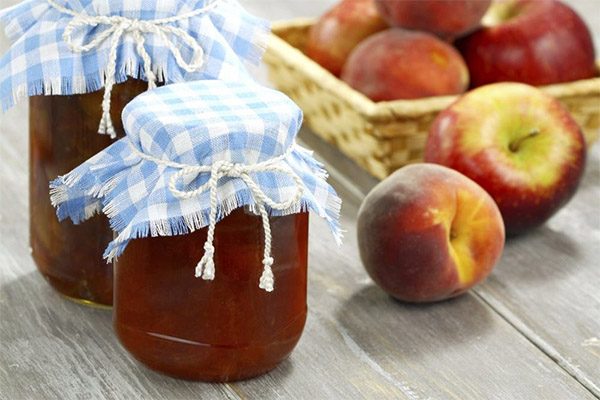
The energy value depends on the amount of sugar added. The average energy value - 258 kcal per 100 grams of finished product:
- proteins - 2 kcal (0.5 g);
- Carbohydrates - 257 kcal (66.8 g).
Fats are completely absent. They are only in the kernels.
The composition of peach treats includes (per 100 g):
- 66.8 g of monosaccharides and disaccharides;
- 31.4 g of water;
- 0.6 g of organic acids;
- 0.4 g of dietary fiber;
- 0.3 g of ash.
What is useful for peach jam
- Peaches have long been known as an excellent natural sedative, antidepressant and good mood stimulant. The jam retains almost all the same beneficial qualities of the fresh fruit.
- The high content of potassium and phosphorus in peaches helps improve memory and cope with cardiovascular disease and circulatory problems. These same minerals improve brain function as well as strengthening the walls of blood vessels.
- Iron helps to increase hemoglobin (peaches contain substances that improve hematopoiesis) and normalize metabolism (by improving the endocrine glands).
- Regular use of peach jam helps to cope with fatigue, stress, nervous tension and insomnia.
- This jam is suitable for those who suffer from low acidity of the stomach, constipation, liver cirrhosis in the early stages.
- Peach jam helps to rejuvenate the body and protect it from early aging.
- Minerals contained in peaches have a beneficial effect on the skin (get rid of rashes and improve complexion) and hair (strengthen them, make them healthier, shiny and silky).
- Jam has a diuretic effect, which has a positive effect in the treatment of urolithiasis. However, fresh fruit is better suited for this purpose.
- Selenium, which is part of the fruit, can serve as a prophylactic for the development of cancer.
How to choose peaches for jam
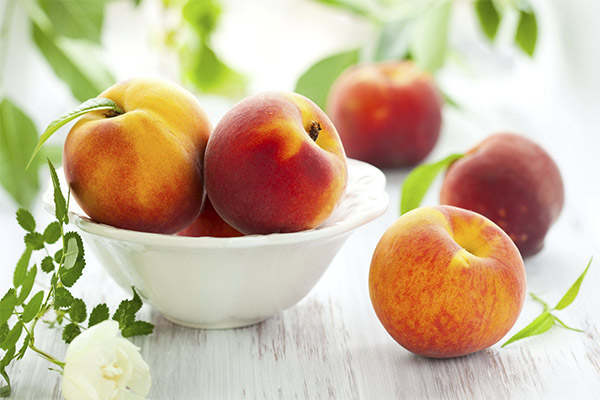
- To achieve a delicate consistency and pleasant flavor of jam, you need to choose only fully ripe (but not overripe and not too soft) or slightly immature fruits with skin that comes off without much effort. The fruit should be firm.
- For a unique amber color you should choose yellow fruits.
- Even if the skin of peaches is not shaggy, it must be removed, because in the process of boiling it separates from the fruit.
- Peaches themselves should be juicy, tasty, without visible damage. Both early and late varieties are suitable for boiling.
Not only the usual shaggy peaches will do, but also nectarines. The requirements for them are similar.
General rules and recommendations
- First of all, it is necessary to choose a suitable utensil. The best is a low enameled container with a thick bottom. To preserve as many useful microelements as possible, you do not need to boil peaches for too long. If the recipe involves a long boil, you can boil the fruit for 5 minutes each day.
- Peaches boiled whole, half, cut into slices or small pieces. Whole peaches should be pierced in several places before boiling, otherwise they can burst. Hard peaches first need to pour hot water and hold it for a few seconds, then pour cold water.
- The fruit should preferably be peeled of the skin. This does not apply to nectarines, because their skin is soft and delicate. However, if you do not remove the skin from the fruit, they will hold their shape better, and the color will be more pleasant - not just golden, but with an orange hue.
- To prevent the peeled fruits from darkening, they should be briefly covered with water acidified with citric acid.
- For cooking it is better to use a deep pan with a thick bottom.
- The ideal ratio of granulated sugar to fruit is 1:1. If the sugar is less, the jam can ferment. The maximum allowable amount of sugar is 1.5 kg per 1 kg of fruit.
- Be sure to add citric acid to the jam. It will help it to thicken properly and prevent sugaring.
- The jam should be boiled and completely cooled several times. This will take a lot of time, but only in this way it can soak up the syrup well, become thicker and more fragrant, get a rich flavor.
- The lids should be taken out of the boiling water only when you need them to close the jars.
- The most undesirable varieties of peaches for jam are white peaches: in this case it will be bitter.
- Too unripe fruit as a component of jam will lead to the fact that the taste of the delicacy will be astringent.
- It is best to use iron lids. Capron lids will be suitable only for the "lazy" version (in this case we are talking about peaches, grinded with sugar).
- If the jam seems to be too liquid, you should boil it for a while longer.
- As the jam is left for a long time, you should prevent insects from getting into it, for example, cover the top with gauze and tie it up.
How to make jam from peaches: recipes
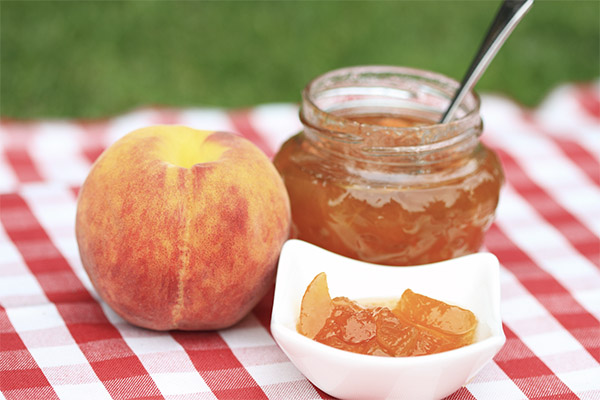
Common peach jam for winter
Need:
- 1 kg of peaches;
- 1 kg of granulated sugar;
- 1 tsp. citric acid;
- vanillin;
- 1 cup boiling water.
Hold clean peaches in boiling water for 15-20 seconds, then transfer them to a bowl filled with cold water acidified with citric acid. Remove the fruit and peel it.
Pour the sugar into the water, stir and put on medium heat. Wait until the mixture boils, skim off the foam that appears. Peaches cut into slices, pips out, pulp drop into the syrup. Repeat the previous steps. Then put in a dark place and leave it to cool. Then restart the boiling process, and when it boils, reduce the heat and cook on low heat for half an hour. When the jam is almost completely boiled, you need to add citric acid. Place the jam in small glass jars, turn them lid down and wrap with a warm blanket or plaid.
The second version of jam for the winter
This recipe uses the same ingredients as in the first version.
Peaches peel from the skin, remove the pips and discard. Fill the pulp with sugar, so that the juice is formed. After a few hours, pour the juice into a saucepan, boil it, and after taking it off the fire, pour it over the pulp. These actions should be repeated several times. The result is a beautiful translucent jam with large uncooked peach pieces.
Peach jam with almonds
Need:
- 1 kg of ripe yellow peaches (regular or nectarines);
- 1 kg granulated sugar;
- 1 cup almonds;
- 2 pinches of cinnamon.
Peaches free from the skin, cut into slices, pour sugar and let stand for a couple of hours. After this time, put the pan on the stove, wait for the mixture to boil, and cook for another 10 minutes. Then remove the foam and leave it overnight, covered with gauze.
Boil almonds for 5 minutes, peel and divide into halves. Put the jam back on the fire, wait until it boils, and pour in the almonds and cinnamon. This mixture should be boiled for another 10 minutes, and then spread into sterilized jars.
Peach jam "Fragrant" with cinnamon
Need:
- 1-1.5 kg of ripe, yellow and firm peaches;
- 1 kg of granulated sugar;
- cinnamon (powder or stick);
- Citric acid on the tip of a knife or 1 lemon.
Peaches free from pips and cut into slices (peel the fruit from the skin in this recipe is not required). Transfer the slices to a deep saucepan. In another deep container pour a glass of water and pour there all the sugar, put on the fire and bring to a boil, stirring occasionally. With the resulting hot syrup pour peach slices, add cinnamon and citric acid. Bring the mixture to a boil, cool completely, then boil and cool again.
If instead of citric acid you use a regular lemon, you need to squeeze the juice from it and pour it into the jam. Then bring the jam to a boil again and boil it for another half an hour. At the end of boiling, take out the cinnamon stick. Place the resulting jam in sterilized jars and seal.
Minimalist whole peaches jam
Ingredients: Peaches and granulated sugar in equal parts.
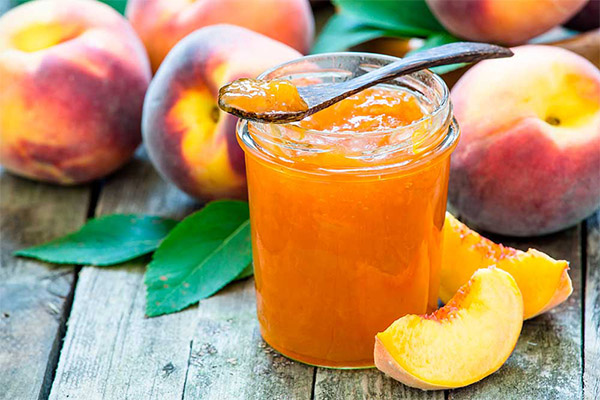
Peaches are washed, peeled and pierced with a fork. Place in a prepared bowl, cover with sugar and leave so for a few hours. Then put the fruits on the fire and cook over low heat for a couple of hours.
Minimalist jam of peach halves
- Pour the peaches for a few seconds in boiling water, and then cold water to make it easier to peel off the skin. Remove the pips, cut the pulp into halves. Prepared fruits alternate with sugar in layers and leave for a few hours until the juice is released.
- After that, put the peaches with the resultant juice on a fire, bring to a boil, cook for a few more minutes and cool completely.
- Take out the peach halves from the syrup, and boil the syrup again on low heat, periodically removing the foam.
- Place the peach halves in the syrup. Bring the mixture back to a boil and place in sterilized jars.
Vitamin peach jam for the lazy Greek way
Ingredients: Peaches and granulated sugar in equal parts.
Cut the fruit in half, take out the pips. Chop the halves with a blender or meat grinder, transfer to a suitable deep container and thoroughly mix with granulated sugar until it is completely dissolved. The resulting mixture transfer to jars and cover with plastic lids.
This option allows you to preserve maximum vitamins and minerals. But you need to remember the specific rules of storage: in this case, the jam is stored only in the refrigerator, and not long at all.
Peach and orange jam
Ingredients:
- 1 kg of slightly underripe peaches;
- 1 kg granulated sugar;
- 1 orange fruit;
- 1 cup boiling water.
Peaches are peeled, pitted, cut into small pieces and put in a prepared bowl. Remove the skin of the orange and squeeze out the juice (preferably through a hand juicer). Strain the juice.
Boil syrup of sugar and water specified in the recipe, add orange juice and cook a few minutes more. Pour the hot mixture over the peach slices. Wait until it has cooled completely. Take out the fruit, boil the syrup and pour it over peaches and oranges again. When the mixture cools, boil the syrup together with fruit pieces on low heat. Fill ready jars and seal them.
Spicy jam
Need:
- 1 kg of hard ripe peaches;
- 1 kg granulated sugar;
- A pinch of saffron and citric acid;
- 1 cup water.
Remove the peel from the fruit, dip it in water with citric acid for a while so that the pulp does not darken. Cut the peaches in half, remove the pips, put them in a bowl. In a pot boil syrup, using sugar and water, pour it over the prepared halves. Leave it for 24 hours. After 24 hours, pour the syrup into the pot and boil it. Again, leave it for 24 hours. After that, the jam should be boiled again, periodically removing the foam, and boil until tender. At the very end, add citric acid and saffron. Spread the jam into clean, dry jars. Instead of a lid, use parchment tied with twine.
Nectarine Jam
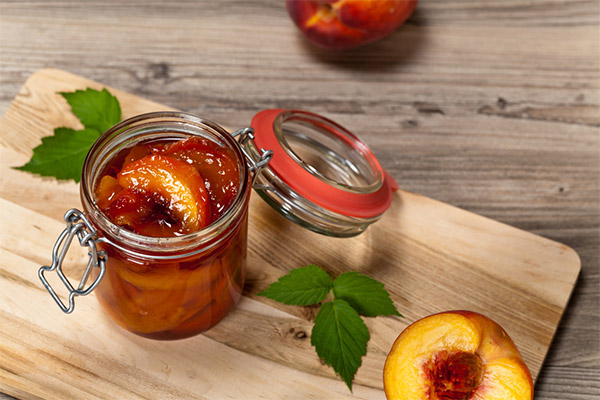
Required:
- 1 kg of ripe nectarines;
- 1 kg granulated sugar;
- lemon juice to taste;
- 1 cup water.
Cut the nectarines in half, remove the pips. Then chop the pulp into pieces. In a saucepan, boil syrup of water and sugar. When it has cooled a little, pour in lemon juice (if you don't have any, you can use regular citric acid). Place the chopped fruit in the syrup, stir and leave for 24 hours. After this time, you need to bring the mixture to a boil, occasionally removing the foam that forms. Leave the jam again for 24 hours. Then boil it down for about 10 minutes. Cooled nectarine jam spread into sterilized jars.
Rules for storing jam
- It is best to use half-liter glass jars (pre-sterilized) for peach jam.
- It is necessary to remember that a large amount of sugar increases the risk of bloating the lid. To prevent this, you need to add citric acid or lemon juice to the jam.
- The thickness of the jam also affects the reliability of storage: the thicker the resulting product, the longer it will last.
- Ideally, peach jam should be stored in the refrigerator. But this possibility is available only if you have two or three jars. If there are more jars, and there is no space in the refrigerator, the jam can be stored at room temperature.
- It is advisable to place the jars in a place closed from sunlight (e.g. pantry).
- It is not necessary to store jam in the cellar: temperature jumps are fraught with the fact that the jar may crack.
If the recipe is followed, the jam can be stored for several years. If for some reason peach jam is cooked with pips, it should not be stored for very long, as a highly dangerous poison, hydrocyanic acid, is released. If the seeds have not been removed from the fruit, the jam should not be stored for longer than 7-8 months.
Opened jars should be kept only in the refrigerator.
If you chose a simplified version of jam (without cooking), the jars should be stored strictly in the refrigerator.
Peach jam: contraindications and precautions
- The jam is strictly forbidden for people suffering from diabetes and obesity.
- With great caution should use jam to women during lactation, as the baby may have an allergic reaction.
- Peach jam can be given to children over one year of age.
- People who suffer from pancreatitis in acute form, use peach jam is prohibited: in such persons, it significantly increases the risk of diabetes. However, during the remission period, jam, on the contrary, will be useful, but only when consumed in small quantities.
- When the acidity of the stomach is reduced, you need to use sour jam, when it is elevated - sweet. If you have gastritis or peptic ulcer, you should consult your doctor before consuming jam.
- If you are hypersensitive to the individual ingredients that make up the jam, and allergic reactions occur, peach jam should be excluded from the diet.
Interesting facts about peaches
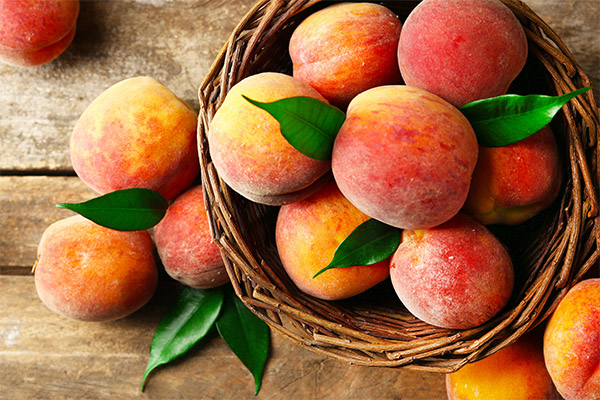
- Although peaches are very useful, they can also cause harm to the body. This is caused by the fact that the fruit has the ability to accumulate pesticides. At the same time, most of them are not destroyed even in the process of boiling.
- In China, the peach tree is still a symbol of longevity. This is due to the fact that in this country since ancient times are familiar with the useful qualities of these tasty and fragrant fruits.
- Peach kernels contain not only hydrocyanic acid, but also peach oil, an ingredient widely used in cosmetology.
- Peach kernels are an ingredient in some kinds of alcoholic products (e.g. liquor and wine).
- Sometimes it is very difficult to separate the kernel from the pulp. In this case, a special spoon is used.
- Peach trees came into being because of repeated crossbreeding of other species - wild peaches, plums, apricots, etc.
- "Peach" in our language comes from the word "Persian" (peach is a Persian apple).
- The country of origin of the peach is most likely northern China.
- The smoothness or "mossiness" of the fruit and the ease of separating the flesh from the seed make it possible to divide peaches into subspecies (regular peaches, nectarines, brunions, etc.).
- Nectarines are the same peaches, but with a smooth skin. They were bred as an alternative to ordinary peaches, which do not tolerate cold.
- Peaches are actively used in cosmetology. They help to moisturize the skin.
- There are different shapes of peaches. The familiar round fruit is not the only option. You can even find flat peaches.
- In our country peaches began to be cultivated in the 16th century in the south.
- The leader in growing peaches is China. In second place is Italy.
- Peach pips are extremely dangerous. Their kernels contain hydrocyanic acid, which is poisonous.
- Wild peaches were used in ancient China as early as 2000 BC.
- Peaches have a beneficial effect on the nervous system, are a powerful antidepressant, relieve insomnia, improve mood, have a calming effect.
- Peaches were eaten even on the moon. It was this fruit that was first eaten by an astronaut during an expedition to a satellite.
- Fresh peaches are low in calories, but they promote a quick and long-lasting feeling of satiety. They are completely fat-free.
- Peaches are rich in minerals that strengthen muscles and the musculoskeletal system.
- Peaches arrived in the Americas thanks to the expedition of Christopher Columbus.
- Heat treatment almost does not deprive peaches of vitamins and minerals, which cannot be said about most other fruits.
- Vitamin A, which the fruit is rich in, is especially useful during vacations because it helps you tan evenly and not get burned.
- One fruit contains half the daily allowance of vitamin C.
- In ancient Greece, the peach appeared in the 4th century BC.
- In the 17th and 18th centuries France was number one in the cultivation of peaches and nectarines.
- The peach is a fruit, not a berry, as it is the juicy fruit of a tree from the ovary of flowers and has a single pit.
- In the territory of modern Europe, the peach is the third most popular fruit after apples and pears.
- The peach is a natural aphrodisiac (helps increase libido). In some Asian countries (Japan and China), it symbolizes fertility.
- The fact that the peach is native to Persia (as the name implies) is a myth. For a long time it was indeed believed so, but this assumption turned out to be erroneous. The peach tree is native to China.
- Haidao is the art of carving fruit pips (primarily peach pips).
«Important: All information on this site is provided for informational purposes only. for information only. Before applying any recommendations, please consult with a specialist. specialist before using any of the recommendations. Neither the editors nor the authors shall be liable for any possible harm caused by materials."


